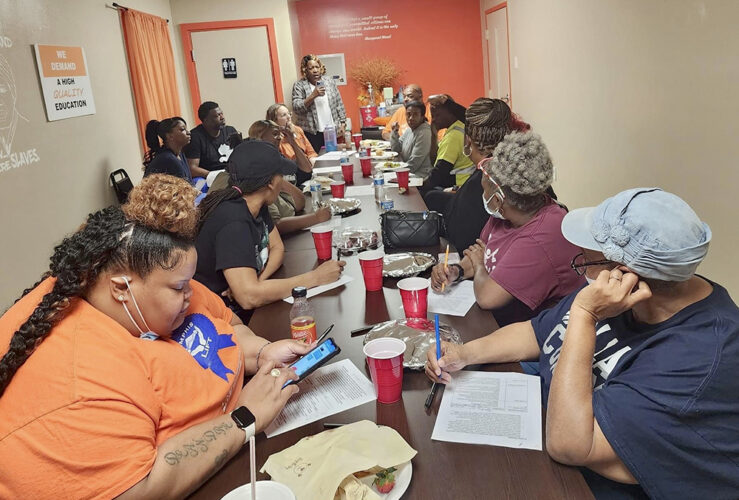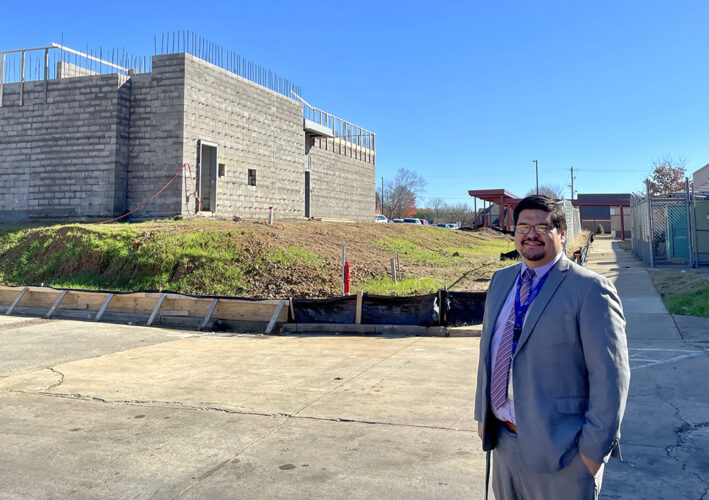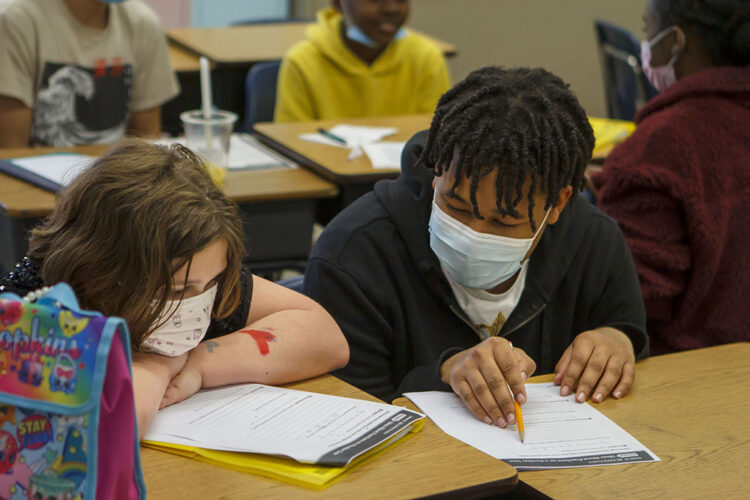The Memphis-Shelby County Schools, Tennessee’s largest district, received almost $776 million in federal relief funds to help students recover from the pandemic — more than any other school system in the state.
But anyone interested in learning how the district spent that hefty sum might be left scratching their heads.
Until a few weeks ago, a web page devoted to the district’s management of the historic windfall contained a link purporting to offer a detailed breakdown of how it used the funds. But clicking it took users to an error page with an illustration of a smiling aviator in a red prop plane, with text reading, “I’m afraid you’ve found a page that doesn’t exist.”

In December, a district spokeswoman said the page wasn’t updated properly and that staff were “working to get everything going smoothly.” But nothing happened until June 11, when the district removed the link after a 74 reporter asked an official about it.
The scenario offers a fitting metaphor for the district’s unwieldy approach to the federal aid amid a season of scandal and other miststeps.
Former Superintendent Joris Ray resigned last year after an investigation showed he had affairs with at least two women he supervised. A turbulent search for a new chief — described by one observer as a “game of thrones,” with the interim and deputy chief vying for the job — has dominated school board meetings. Other distractions, notably a move to bar critics from board meetings, has eroded trust between leaders and families, and hindered transparency about the biggest pot of federal money the majority Black district has ever received.
“They are going through a lot right now,” said Krista Johnson, founder and executive director of ALLMemphis, a nonprofit that provides literacy training and coaching to teachers. She described her interactions with the district as “swimming upstream”: Emails to officials aren’t returned for weeks, and communication with principals is poor.
Johnson said the problems hit home recently when she learned that her first grader in the district is a year behind in reading — despite getting A’s on weekly tests and making the principal’s list. As an educator, Johnson understands that it’s harder for a student to do well on a standardized test than a weekly spelling quiz. But she thinks the district could do a better job of explaining these issues to families.
“Nothing works well without strong leadership, and we just don’t have strong leadership now,” she said. “It’s just not an emergency to anyone, and that is shameful.”
With the attention on crisis management, oversight of relief funds has suffered.
An investigation last year showed the district overspent relief funds on HVAC systems — sometimes six times as much — in a rush to beat other districts competing for the same vendors. Prior to the federal windfall, the average HVAC project cost $1 million; afterwards, it jumped to $6 million.
The district fired its facilities manager last July after an internal probe showed he approved purchases from a business in exchange for that firm doing work with his own company.
After a January audit found “significant deficiency” in the district’s handling of contracts, officials hired FORVIS, an outside accounting firm, to examine its use of relief funds. Both the district and a FORVIS spokesman declined to comment on the status of the audit.
Sheleah Harris, who abruptly resigned from the school board earlier this month, has cast further doubt on how the district has handled the money. In an email to reporters, she alleged that board members and administrators “have directly benefited from certain contracts.” While she didn’t offer specifics, she accused Board Chair Althea Greene of “mishandling” funds.
The district, which has more than $500 million in relief funds yet to spend, pointed to the audit and its own “corrective actions” as proof of efforts to prevent impropriety. Greene denied the accusations and said she carries her “responsibility with the utmost integrity.”
‘Skin in the game’
The litany of flare-ups has tried the patience of parents eager to see results from the federal investment. “We need to know where this money is going,” said Sarah Carpenter, executive director of Memphis Lift, a leading advocacy group. “The board isn’t talking about it.”
On a weeknight, she gathered with parents at the organization’s headquarters — a one-story white bungalow with orange trim in north Memphis, a predominantly Black community. The converted house serves as a gathering spot for families to discuss pressing issues, like a new curriculum or school choice options.
That evening, as children played in another room, at least a dozen parents and grandparents sat around a long table, shared dinner and voiced frustrations about classrooms without certified teachers and student data portals with no grades.

They described themselves as only vaguely aware of how much money the district received in relief funds and how officials were using it.
“The district has not been very informative,” said Charles Lampkin, a pastor with six children in the Memphis-Shelby schools, from 3 to 13. “I’ve got a lot of skin in the game.”
The communication breakdown is notable given the school system’s place among urban districts nationally, where it experienced some of the largest declines in reading and math on last year’s National Assessment of Educational Progress. Math scores fell 12 points in fourth grade and 14 points in eighth grade. In reading, there was an eight-point drop in fourth and a six-point decline in eighth.
Considering the dismal results, Carpenter wonders whether leaders have made the best use of the money. “When we look up and the money’s gone, will our kids be in the same shape?” she asked. “I’m afraid so.”
Before the NAEP scores were released, former state education Commissioner Penny Schwinn met with Williams, the interim superintendent, and other leaders in downtown Memphis to brace them for the results.
Memphis-Shelby, she said later, hadn’t “rigorously” communicated with families of students at risk of repeating third grade this fall due to a new state law requiring proficiency in reading.
The latest results showed that 42% of third graders scored below expectations — the same as last year.
“Our concern is we will have thousands of kids, predominantly Black children in Memphis, who will be retained — not because they had to be, but literally because there isn’t a structure,” Schwinn said. Officials “are wanting to do all the right things. The implementation is where there’s a lot of struggle.”
She said district leaders could have spent relief funds to hire a public relations firm to explain the options for students who didn’t reach proficiency. “Outsource it. It’s allowable,” Schwinn said.
The district held a series of Facebook live sessions on the results, but declined to comment to The 74 on steps teachers took to inform parents of their children’s performance. State data shows 95% of those eligible to retake the test in late May did, but of those, just 8% became proficient.
‘When the storm comes’
Meanwhile, Greene, the board chair, pushed back on the idea that district scandals have caused relief efforts to falter.
“We didn’t get off track. We had a plan and we stuck to it,” she said in an interview. She thinks the board earned the community’s respect when it put former superintendent Ray on leave and ultimately negotiated his resignation. “We didn’t have a manual to say this is what you do when the storm comes.”
Far from fumbling its message, she insisted the district “over-communicates” about relief funds.
“We have a website,” she said in December. As evidence, she pointed a 74 reporter to the site with the error message and bouncing airplane. Contacted again on June 11, she said the site had been updated. The change, it appears, was to remove the link altogether, leaving the public without a breakdown of how the district has spent the funds. The rest of the site remains stuck in the earlier days of relief fund implementation: It features a video with former superintendent Ray and its most recent spending report is from February 2022.
In June, a spokesperson said the website isn’t the primary vehicle to communicate to families about relief-funded programs. She pointed to a newsletter launched last fall, but a review of several issues shows it’s a roundup of calendar items, awards and other updates without any mention of how the district is using the money.
Several parents and community leaders said they were unaware of recent efforts to communicate how the funds have been spent. Terence Patterson, president and CEO of the Memphis Education Fund, voiced concerns that the district was allocating too much — over $400 million — on facility upgrades and deferred maintenance and not enough on academic recovery. Records show the district has spent almost $127 million on “building improvements” and architects. In addition to new HVAC systems, major projects include painting, renovating athletic fields and stadiums, and installing water filling stations and new fire alarms.
Williams, the interim superintendent, defended those actions.
“We are a district that’s been around for quite some time. We have over 200 facilities and those facilities are really aging,” she said. “This was a once in a lifetime opportunity.”

Tutoring efforts
The ongoing turmoil has tended to obscure what leaders say are important milestones toward getting more students on grade level.
The district has spent over $40 million on tutoring this school year, reaching 13,300 students, officials said. Only a few schools had waitlists and the majority of parents who requested tutoring received it. Attendance at tutoring sessions averaged 89% and students who participated in at least half were more likely to meet the district’s growth goal each quarter, officials said.
“There are folks who keep the ball rolling,” said Cortney Robinson, CEO of the Peer Power Foundation, a nonprofit that has received almost $3.9 million in relief funds to train high school students as tutors. He called Deputy Superintendent Angela Whitelaw and Shawn Page, chief of academic operations, “heroes” who haven’t let the tensions interfere with academic recovery.

Another $89 million is paying for 750 “specialized classroom assistants” in K-2. They lead small groups of students for practice on specific skills, monitor students’ work while teachers are leading lessons and provide backup in the early grades.
Jessica Rodriguez, who has a first grader at Willow Oaks Elementary, took the position because she worried about the pandemic’s effect on her son’s learning.
“I just really wanted to be a support,” she said. “I have a better connection [to the school] than I had before.”

Williams told The 74 the district will evaluate its tutoring and K-2 initiatives to determine if it wants to continue them when relief funds expire.
“You do not sustain $776 million overnight,” she said. “You have to be more strategic in your thinking on what is really working for students.”
But during a May 9 meeting, Whitelaw, the district’s deputy chief, said the district can’t yet determine whether hiring the classroom assistants was a wise use of relief funds. Some of the assistants led classrooms on their own this past school year because of staff shortages and haven’t been used to “their fullest potential,” she said.

At the same meeting, Harris thumbed through the district’s spending plan. She bluntly called the district “top, top, top heavy, heavy, heavy” and said it was unclear whether the 1,163 positions hired with relief funds supported academic goals. Experts warned districts against using the money to hire staff because after next year, they’ll either have to let them go or find another way to pay them.
She said district officials ought to tell parents in “community-friendly language” where the relief funds are going. Harris thinks that message, three years after the pandemic began, should answer a fundamental question: “Does this tie into making sure our children can read on grade level or above?”
Get stories like these delivered straight to your inbox. Sign up for The 74 Newsletter

